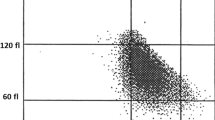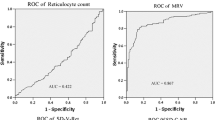Abstract
The objective of this study is to compare and evaluate the diagnostic value of hereditary spherocytosis (HS) by three screening tests, comparing mean spherical corpuscular volume (MSCV) to mean corpuscular volume (MCV), mean corpuscular hemoglobin concentration (MCHC), and flow cytometric osmotic fragility test. Peripheral blood was collected from 237 participators diagnosed at the First Affiliated Hospital of Guangxi Medical University, including 56 hereditary spherocytosis patients, 86 thalassemia patients, and 95 healthy people. The samples were examined by three tests, and the three screening tests were evaluated by the sensitivity and specificity of tests. The sensitivity was only 41.07 %, and specificity was 94.47 % when using MCHC >355 g/L as diagnostic criteria. The sensitivity was 89.28 %, and specificity was 96.14 % when using MSCV < MCV as the optimum cutoff point. When using the residual red cell percentage <23.6 % as the diagnostic threshold in flow cytometric osmotic fragility test, the sensitivity was 85.71 % and the specificity was 97.24 %. Flow cytometry osmotic fragility test or comparing MSCV to MCV combined with smear examination of peripheral red blood cells morphology can be a simple, practical, and accurate hereditary spherocytosis (HS) laboratory screening method.



Similar content being viewed by others
References
Perrotta S, Gallagher PG, Mohandas N (2008) Hereditary spherocytosis. Lancet 372(9647):1411–1426
Hayag-Barin JE, Smith RE, Tucker FC Jr (1998) Hereditary spherocytosis, thrombocytosis, and chronic pulmonary emboli: a case report and review of the literature. Am J Hematol 57(1):82–84
Kar R, Saxena R, Pati HP (2008) Hereditary spherocytosis with high fetal hemoglobin: an interesting case. Hemoglobin 32(5):520–523
Afshar A (2012) A case of Kienbock’s disease and hereditary spherocytosis anaemia. J Hand Surg Eur 37(5):466–467
Oliveira MC, Fernandes RA, Rodrigues CL, Ribeiro DA, Giovanardi MF, Viana MB (2012) Clinical course of 63 children with hereditary spherocytosis: a retrospective study. Rev Bras Hematol Hemoter 34(1):9–13
Bianchi P, Fermo E, Vercellati C, Marcello AP, Porretti L, Cortelezzi A et al (2012) Diagnostic power of laboratory tests for hereditary spherocytosis: a comparison study in 150 patients grouped according to molecular and clinical characteristics. Haematologica 97(4):516–523
Kutter D (2005) Hereditary spherocytosis is more frequent than expected: what to tell the patient? Bull Soc Sci Med Grand Duche Luxemb 1:7–22
Bolton-Maggs PH, Stevens RF, Dodd NJ, Lamont G, Tittensor P, King MJ et al (2004) Guidelines for the diagnosis and management of hereditary spherocytosis. Br J Haematol 126(4):455–474
Bolton-Maggs PH, Langer JC, Iolascon A, Tittensor P, King MJ (2012) General Haematology Task Force of the British Committee for Standards in H. Guidelines for the diagnosis and management of hereditary spherocytosis—2011 update. Br J Haematol 156(1):37–49
Won DI, Suh JS (2009) Flow cytometric detection of erythrocyte osmotic fragility. Cytometry B Clin Cytom 76(2):135–141
Warang P, Gupta M, Kedar P, Ghosh K, Colah R (2011) Flow cytometric osmotic fragility—an effective screening approach for red cell membranopathies. Cytometry B Clin Cytom 80(3):186–190
Demir A, Yarali N, Fisgin T, Duru F, Kara A (2002) Most reliable indices in differentiation between thalassemia trait and iron deficiency anemia. Pediatr Int Off J Japan Pediatr Soc 44(6):612–616
Beyan C, Kaptan K, Ifran A (2007) Predictive value of discrimination indices in differential diagnosis of iron deficiency anemia and beta-thalassemia trait. Eur J Haematol 78(6):524–526
Broseus J, Visomblain B, Guy J, Maynadie M, Girodon F (2010) Evaluation of mean sphered corpuscular volume for predicting hereditary spherocytosis. Int J Lab Hematol 32(5):519–523
Lin FQTJ, Ju Y, Qiu YL (2010) The value of mean spherical corpuscular volume in diagnosis of hereditary spherocytosis. J Pract Med 26(14):2537–2539
Zarandona JM, Yazer MH (2006) The role of the Coombs test in evaluating hemolysis in adults. CMAJ Can Med Assoc J J Assoc Med Can 174(3):305–307
Eber SW, Pekrun A, Neufeldt A, Schroter W (1992) Prevalence of increased osmotic fragility of erythrocytes in German blood donors: screening using a modified glycerol lysis test. Ann Hematol 64(2):88–92
Vettore L, Zanella A, Molaro GL, De Matteis MC, Pavesi M, Mariani M (1984) A new test for the laboratory diagnosis of spherocytosis. Acta Haematol 72(4):258–263
Mittler U, Radig K, Kluba U, Aumann V, Roppnack R (1993) Experience with the glycerol lysis test in acid medium in diagnosis of hereditary spherocytosis. Kinderarztliche Praxis 61(6):219–222
Hoffmann JJ, Swaak-Lammers N, Breed WP, Strengers JL (1991) Diagnostic utility of the pre-incubated acidified glycerol lysis test in haemolytic and non-haemolytic anaemias. Eur J Haematol 47(5):367–370
King MJ, Zanella A (2013) Hereditary red cell membrane disorders and laboratory diagnostic testing. Int J Lab Hematol 35(3):237–243
Park ES, Jung HL, Kim HJ, Park SS, Bae SH, Shin HY et al (2013) Hereditary hemolytic anemia in Korea from 2007 to 2011: a study by the Korean Hereditary Hemolytic Anemia Working Party of the Korean Society of Hematology. Blood Res 48(3):211–216
Da Costa L, Galimand J, Fenneteau O, Mohandas N (2013) Hereditary spherocytosis, elliptocytosis, and other red cell membrane disorders. Blood Rev 27(4):167–178
Acknowledgments
This study was supported by the National Natural Science Foundation of China (No. 81360263) and the Provincial Natural Science Foundation of Guangxi (2011GXNSFA018290).
Conflict of interest
The authors declare that they have no conflict of interest.
Author information
Authors and Affiliations
Corresponding author
Additional information
The authors Yi-feng Tao and Zeng-fu Deng contributed equally to this work.
Rights and permissions
About this article
Cite this article
Tao, Yf., Deng, Zf., Liao, L. et al. Comparison and evaluation of three screening tests of hereditary spherocytosis in Chinese patients. Ann Hematol 94, 747–751 (2015). https://doi.org/10.1007/s00277-014-2270-2
Received:
Accepted:
Published:
Issue Date:
DOI: https://doi.org/10.1007/s00277-014-2270-2




